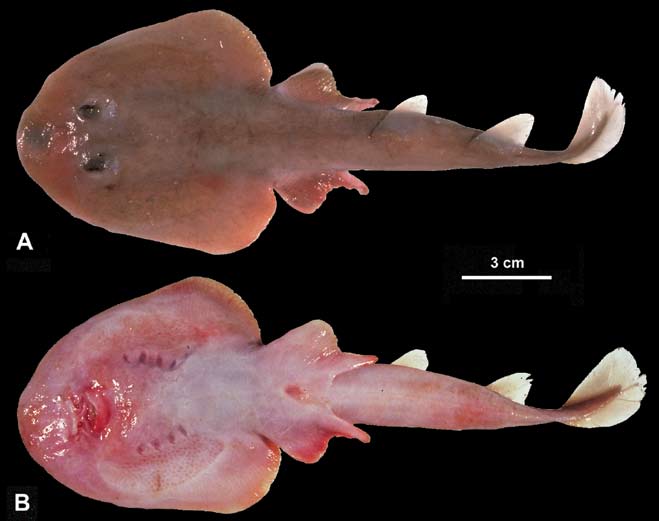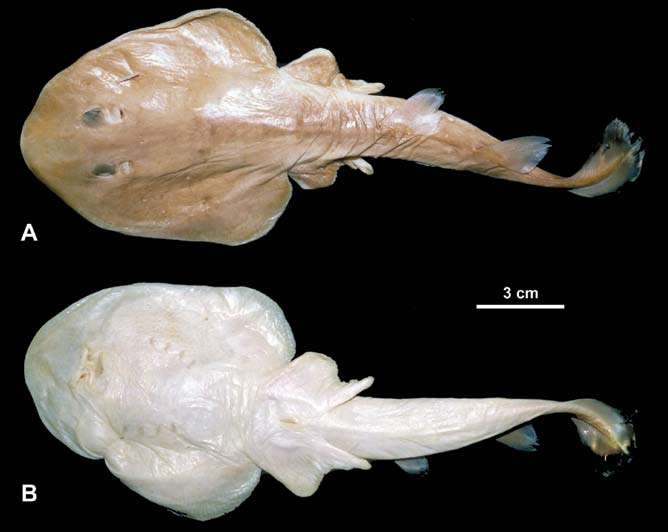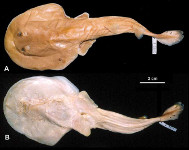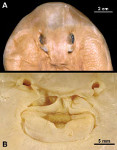Narcinops nelsoni
(Carvalho, 2008)
Eastern numbfish
Classification: Elasmobranchii Torpediniformes Narcinidae
Reference of the original description
New species of numbfishes from Australia, with a key to Australian electric rays of the genus Narcine Henle, 1834 (Chondrichthyes: Torpediniformes: Narcinidae). CSIRO Marine and Atmospheric Research Paper, 22, 241–260
New species of numbfishes from Australia, with a key to Australian electric rays of the genus Narcine Henle, 1834 (Chondrichthyes: Torpediniformes: Narcinidae). CSIRO Marine and Atmospheric Research Paper, 22, 241–260
Image of the original description

Coloration in freshly collected holotype of Narcinops nelsoni sp. nov. (CSIRO H 719–06, 260 mm TL adult male, Capricorn Channel, Queensland): (A) dorsal view; (B) ventral view.In: De Carvalho, M.R. (2008): New species of numbfishes from Australia, with a key to Australian electric rays of the genus Narcine Henle, 1834 (Chondrichthyes: Torpediniformes: Narcinidae). CSIRO Marine and Atmospheric Research Paper, 22: 241-260

Coloration in freshly collected holotype of Narcinops nelsoni sp. nov. (CSIRO H 719–06, 260 mm TL adult male, Capricorn Channel, Queensland): (A) dorsal view; (B) ventral view.In: De Carvalho, M.R. (2008): New species of numbfishes from Australia, with a key to Australian electric rays of the genus Narcine Henle, 1834 (Chondrichthyes: Torpediniformes: Narcinidae). CSIRO Marine and Atmospheric Research Paper, 22: 241-260
Synonyms / new combinations and misspellings
Narcine nelsoni, Narcinops cf. nelsoni
Narcine nelsoni, Narcinops cf. nelsoni
Types
Narcinops nelsoni
Narcine nelsoni
Holotype: CSIRO: H 719-06; Paratype: CSIRO: H 719-11; CSIRO: H 719-10; CSIRO: H 719-09; CSIRO: H 719-07; CSIRO: H 719-08; CSIRO: H 719-04; CSIRO: H 719-05; CSIRO: H 719-03; CSIRO: H 719-02; CSIRO: H 719-01; NMV: A 4390; QM: I 20009; QM: I 22095; QM: I 18761;
Narcinops nelsoni
Narcine nelsoni
Holotype: CSIRO: H 719-06; Paratype: CSIRO: H 719-11; CSIRO: H 719-10; CSIRO: H 719-09; CSIRO: H 719-07; CSIRO: H 719-08; CSIRO: H 719-04; CSIRO: H 719-05; CSIRO: H 719-03; CSIRO: H 719-02; CSIRO: H 719-01; NMV: A 4390; QM: I 20009; QM: I 22095; QM: I 18761;
Description :
Citation: Narcinops nelsoni (Carvalho, 2008): In: Database of modern sharks, rays and chimaeras, www.shark-references.com, World Wide Web electronic publication, Version 01/2026
Please send your images of "Narcinops nelsoni" to info@shark-references.com

Holotype of Narcinops nelsoni sp. nov. (CSIRO H 719–06, 260 mm TL adult male, Capricorn Channel, Queensland) in dorsal (A) and ventral (B) views. Caudal fin is downturned in (B). In: De Carvalho, M.R. (2008): New species of numbfishes from Australia, with a key to Australian electric rays of the genus Narcine Henle, 1834 (Chondrichthyes: Torpediniformes: Narcinidae). CSIRO Marine and Atmospheric Research Paper, 22: 241-260

Holotype of Narcinops nelsoni sp. nov. (CSIRO H 719–06, 260 mm TL adult male, Capricorn Channel, Queensland) in dorsal (A) and ventral (B) views. Caudal fin is downturned in (B). In: De Carvalho, M.R. (2008): New species of numbfishes from Australia, with a key to Australian electric rays of the genus Narcine Henle, 1834 (Chondrichthyes: Torpediniformes: Narcinidae). CSIRO Marine and Atmospheric Research Paper, 22: 241-260
Common names
 Eastern numbfish
Eastern numbfish
 Eastern numbfish
Eastern numbfish
Short Description
Original diagnosis after CARVALHO, 2008 [3349]: A species of Narcine distinguished from most congeners by presenting tail length, as measured from cloaca, much longer than disc width or length (tail length averaging 54.1% TL, compared to 38.4% and 40.2% for disc width and length, respectively) (vs. tail length smaller than, or subequal to, disc width and length in all other species of Narcine, except N. westraliensis, N. ornata, N. rierai, N. tasmaniensis, and N. lasti). From N. westraliensis and N. ornata, N. nelsoni sp. nov. is distinguished by presenting a uniform light brown dorsal coloration, devoid of any spots or distinctive markings (vs. dorsal coloration composed of horizontal stripes in N. westraliensis, and a unique arrangement of spots and blotches in N. ornata; see description of this species above). From N. rierai, N. nelsoni sp. nov. is distinguished by its much wider than long nasal curtain (vs. nasal curtain slightly longer than wide in N. rierai). From N. tasmaniensis, N. nelsoni sp. nov. is clearly distinguished by having a ridge-like lateral tail fold (vs. lateral tail fold wider and flap-like in N. tasmaniensis), and by its light brown dorsal coloration (vs. usually chocolate brown in N. tasmaniensis). Narcine lasti and N. nelsoni sp. nov. are distinct in dorsal coloration (light brown in the latter species, vs. yellowish-brown in N. lasti), and numbers of exposed tooth rows (relatively fewer rows in N. nelsoni: 9–16/5–12 exposed rows, typically with 12/9 exposed rows in adults, vs. 11–20/8–15 rows in N. lasti, typically with 19/15 rows in adults). Certain proportional measurements further distinguish N. nelsoni sp. nov. from N. tasmaniensis and N. lasti.
Original diagnosis after CARVALHO, 2008 [3349]: A species of Narcine distinguished from most congeners by presenting tail length, as measured from cloaca, much longer than disc width or length (tail length averaging 54.1% TL, compared to 38.4% and 40.2% for disc width and length, respectively) (vs. tail length smaller than, or subequal to, disc width and length in all other species of Narcine, except N. westraliensis, N. ornata, N. rierai, N. tasmaniensis, and N. lasti). From N. westraliensis and N. ornata, N. nelsoni sp. nov. is distinguished by presenting a uniform light brown dorsal coloration, devoid of any spots or distinctive markings (vs. dorsal coloration composed of horizontal stripes in N. westraliensis, and a unique arrangement of spots and blotches in N. ornata; see description of this species above). From N. rierai, N. nelsoni sp. nov. is distinguished by its much wider than long nasal curtain (vs. nasal curtain slightly longer than wide in N. rierai). From N. tasmaniensis, N. nelsoni sp. nov. is clearly distinguished by having a ridge-like lateral tail fold (vs. lateral tail fold wider and flap-like in N. tasmaniensis), and by its light brown dorsal coloration (vs. usually chocolate brown in N. tasmaniensis). Narcine lasti and N. nelsoni sp. nov. are distinct in dorsal coloration (light brown in the latter species, vs. yellowish-brown in N. lasti), and numbers of exposed tooth rows (relatively fewer rows in N. nelsoni: 9–16/5–12 exposed rows, typically with 12/9 exposed rows in adults, vs. 11–20/8–15 rows in N. lasti, typically with 19/15 rows in adults). Certain proportional measurements further distinguish N. nelsoni sp. nov. from N. tasmaniensis and N. lasti.
Distribution
Western Pacific: Australia.
Western Pacific: Australia.
Remarks
shark-references Species-ID=14813;
shark-references Species-ID=14813;


















